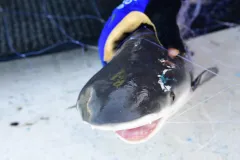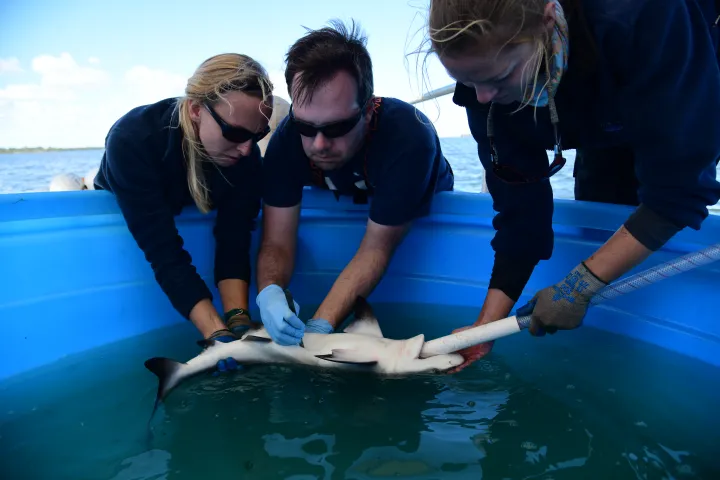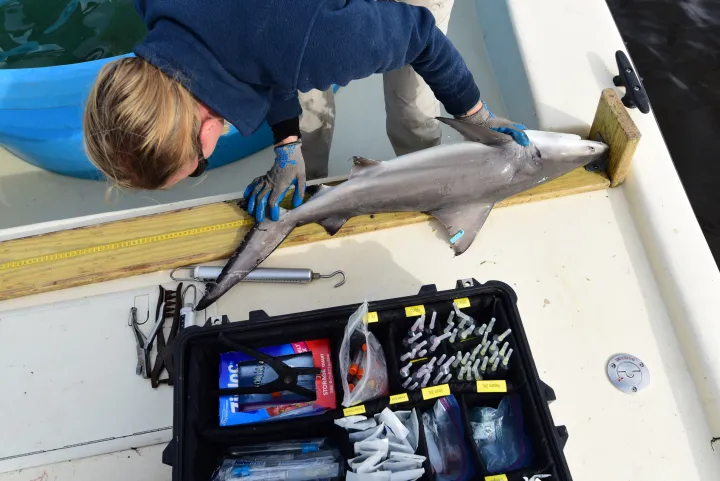How Climate Change is Impacting Shark Mothering

As any mother knows, ensuring the safety of your kids is a tough job. For bull sharks, mothers give birth in protected inlets along the shore to give their offspring a leg up at survival. As adults, these massive sharks can hold their own in coastal environments, and can even consume prey as large as bottlenose dolphins, but young bull sharks aren’t the same formidable predators yet. The young sharks require a more protected environment with ample food, safety from predators (like other sharks), and warm, controlled temperatures. Bays and lagoons, with all of these characteristics, make a perfect shark “nursery” where a young shark can grow.
Until recently, along the East Coast of the United States, the most northerly of these shark nurseries existed in the Indian River Lagoon in Florida. But a new study shows that rising temperatures due to climate change have turned one estuary in North Carolina into a suitable habitat, and mother sharks are taking notice.
Every year the North Carolina Division of Marine Fisheries sets out gillnets in the Pamlico Sound of North Carolina in an effort to determine population numbers of economically important fish. Even though they don’t intend to catch sharks, inevitably a few get tangled in the gear and are tallied along with the fish. Historically, this has been rare—only nine juvenile bull sharks were caught between 1965 and 2011.
“Then in 2012 they spiked up,” says Charles Bangley, a researcher at the Smithsonian Environmental Research Center (SERC) and lead author on the study that analyzed the fisheries data. “They’ve gone from being a very rare, sporadic catch to something you can reliably catch.”
Since 2011, 64 juvenile sharks have been captured in Pamlico Sound, indicating mother bull sharks that once made the journey south to Florida to give birth are now forgoing the long trek and instead staying off the coast of North Carolina. Most of the juvenile sharks are within the size range of a one or two year old and, since newborn sharks tend to stay in or near their nursery habitat for the first few years of life, it is most likely that they are born in the sound. They also appear at the end of May into early June, around the same time that the juveniles are known to be born in the Indian River Lagoon in Florida.
After the initial discovery of the shark population spike, scientists became curious—why the sudden affinity for Pamlico Sound? Combing through two different sets of environmental data that included water conditions like salinity, temperature, and oxygen content (to name a few), the scientists found that elevated salinity levels and temperature were linked to a higher presence of juvenile sharks. Specifically, the data showed that after 2008 the average temperature was no longer dipping below 77 degrees Fahrenheit (25 degrees Celsius). Bull sharks normally don’t live in areas below 72 degrees Fahrenheit (22 degrees Celsius).
“The lower level of the temperature range keeps going up. The maximum goes up a little but it’s that lower limit that keeps going up,” says Bangley. “Probably around 2011 or 2012 it hit a threshold where some mother bull shark decided it could just pop in there (Pamlico Sound) instead.”
But while the juveniles that are born in Florida tend to overwinter in the lagoon, it is believed that the North Carolina sharks are finding Pamlico’s water a tad too chilly still and instead are traveling down the coast to find warmer water. One tagged shark tagged in Pamlico in September traversed down to South Carolina by November.
“From the shark’s perspective, it’s a positive thing that they’ve moved into Pamlico Sound because it shows that unlike salmon that depend upon going back to the same river every time, these bull sharks have some measure of adaptability in terms of where they can drop their young off.”
Now scientists are turning their attention to answering the question of where these sharks came from and what impact they might have on the food web in the sound. Climate change has already shifted many species’ ranges towards the poles, like the northward shift of the American lobster, and oftentimes this creates a mismatch in food availability. It’s still unclear how the young shark newcomers will impact the Pamlico Sound ecosystem and so continued monitoring will be key to understanding a future with these toothy inhabitants.
It’s also heartening to know that despite dramatic changes in the environment due to climate change, baby bull sharks will continue to have a safe place to call home.



